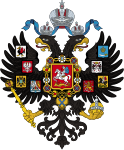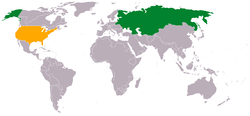The diplomatic history of the United States oscillated among three positions: isolation from diplomatic entanglements of other nations ; alliances with European and other military partners; and unilateralism, or operating on its own sovereign policy decisions. The US always was large in terms of area, but its population was small, only 4 million in 1790. Population growth was rapid, reaching 7.2 million in 1810, 32 million in 1860, 76 million in 1900, 132 million in 1940, and 316 million in 2013. Economic growth in terms of overall GDP was even faster. However, the nation's military strength was quite limited in peacetime before 1940.

Pax Britannica was the period of relative peace between the great powers. During this time, the British Empire became the global hegemonic power, developed additional informal empire, and adopted the role of a "global policeman".

The Alaska boundary dispute was a territorial dispute between the United States and the United Kingdom of Great Britain and Ireland, which then controlled Canada's foreign relations. It was resolved by arbitration in 1903. The dispute had existed between the Russian Empire and Britain since 1821, and was inherited by the United States as a consequence of the Alaska Purchase in 1867. The final resolution favored the American position, as Canada did not get an all-Canadian outlet from the Yukon gold fields to the sea. The disappointment and anger in Canada was directed less at the United States, and more at the British government for betraying Canadian interests in favor of healthier Anglo-American relations.

The Kingdom of France was the first friendly country of the new United States in 1778. The 1778 Treaty of Alliance between the two countries and the subsequent aid provided from France proved decisive in the American victory over Britain in the American Revolutionary War. France, however, was left heavily indebted after the war, which contributed to France's own revolution and eventual transition to a republic.

Relations between the Japanese Empire and the Russian Empire (1855–1917) were minimal until 1855, mostly friendly from 1855 to the early 1890s, but then turned hostile, largely over the status of Manchuria and of Korea. The two empires established diplomatic and commercial relations from 1855 onwards. The Russian Empire officially ended in 1917, and was succeeded by Communist rule formalized in 1922 with the formation of the Soviet Union.

Relations between the Soviet Union and the United States were fully established in 1933 as the succeeding bilateral ties to those between the Russian Empire and the United States, which lasted from 1776 until 1917; they were also the predecessor to the current bilateral ties between the Russian Federation and the United States that began in 1992 after the end of the Cold War. The relationship between the Soviet Union and the United States was largely defined by mistrust and tense hostility. The invasion of the Soviet Union by Germany as well as the attack on the U.S. Pacific Fleet at Pearl Harbor by Imperial Japan marked the Soviet and American entries into World War II on the side of the Allies in June and December 1941, respectively. As the Soviet–American alliance against the Axis came to an end following the Allied victory in 1945, the first signs of post-war mistrust and hostility began to immediately appear between the two countries, as the Soviet Union militarily occupied Eastern European countries and turned them into satellite states, forming the Eastern Bloc. These bilateral tensions escalated into the Cold War, a decades-long period of tense hostile relations with short phases of détente that ended after the collapse of the Soviet Union and emergence of the present-day Russian Federation at the end of 1991.

The bilateral relations between Canada and the United Kingdom have yielded intimate and frequently-co-operative contact since Canada gained independence in 1931. Canada was previously self-governing since 1 July 1867, the date that became Canada's independence day.
Diplomacy was a central component of the American Revolutionary War and broader American Revolution. In the years leading up to the outbreak of military hostilities in 1775, the Thirteen Colonies and Great Britain had sought a peaceful diplomatic solution within the British political system. Once fighting began, diplomacy in the American Revolutionary War became critical to each faction for both strategic and ideological reasons. The American colonists sought forward aid and support to counter Great Britain's overwhelming strategic, military, and manpower advantages as well as to garner political legitimacy through international recognition; Great Britain sought to contain these diplomatic overtures while also leveraging its foreign relations with Native American tribes and German states. The American Declaration of Independence in July 1776 escalated these developments as the erstwhile sovereign United States evolved an independent foreign policy. Diplomacy would prove critical to shaping the trajectory and outcome of the war, as Americans relations with several foreign powers—particularly France and Spain—allowed access to decisive war material, funds, and troops while at the same time isolating Britain globally and spreading thin its military.

The Franco-American alliance was the 1778 alliance between the Kingdom of France and the United States during the American Revolutionary War. Formalized in the 1778 Treaty of Alliance, it was a military pact in which the French provided many supplies for the Americans. The Netherlands and Spain later joined as allies of France; Britain had no European allies. The French alliance was possible once the Americans captured a British invasion army at Saratoga in October 1777, demonstrating the viability of the American cause. The alliance became controversial after 1793 when Great Britain and Revolutionary France again went to war and the U.S. declared itself neutral. Relations between France and the United States worsened as the latter became closer to Britain in the Jay Treaty of 1795, leading to an undeclared Quasi War. The alliance was defunct by 1794 and formally ended in 1800.
History of United States foreign policy is a brief overview of major trends regarding the foreign policy of the United States from the American Revolution to the present. The major themes are becoming an "Empire of Liberty", promoting democracy, expanding across the continent, supporting liberal internationalism, contesting World Wars and the Cold War, fighting international terrorism, developing the Third World, and building a strong world economy with low tariffs.

This timeline covers the main points of British foreign policy from 1485 to the early 21st century.

This article covers worldwide diplomacy and, more generally, the international relations of the great powers from 1814 to 1919. This era covers the period from the end of the Napoleonic Wars and the Congress of Vienna (1814–1815), to the end of the First World War and the Paris Peace Conference (1919–1920).

During the American Revolution, Russia remained neutral in the conflict between Great Britain and rebelling colonists in Thirteen Colonies of the British Empire. Prior to the war's outbreak in 1775, Russian colonisers, operating under the ultimate direction of Empress Catherine the Great, had begun exploring the Western Seaboard, and in 1784 began colonizing Alaska, establishing the colony of Russian America. Although Russia did not directly become involved in the conflict, with Catherine rejecting British diplomatic overtures to dispatch the Imperial Russian Army to North America, the Russians did play a major role in diplomacy in the American Revolutionary War and contributed to the lasting legacy of the American Revolution abroad.
The diplomacy of the American Civil War involved the relations of the United States and the Confederate States of America with the major world powers during the American Civil War of 1861–1865. The United States prevented other powers from recognizing the Confederacy, which counted heavily on Britain and France to enter the war on its side to maintain their supply of cotton and to weaken a growing opponent. Every nation was officially neutral throughout the war, and none formally recognized the Confederacy.
The history of the foreign relations of the United Kingdom covers English, British, and United Kingdom's foreign policy from about 1500 to 2000. For the current situation since 2000 see foreign relations of the United Kingdom.
International relations (1919–1939) covers the main interactions shaping world history in this era, known as the interwar period, with emphasis on diplomacy and economic relations. The coverage here follows the diplomatic history of World War I and precedes the diplomatic history of World War II. The important stages of interwar diplomacy and international relations included resolutions of wartime issues, such as reparations owed by Germany and boundaries; American involvement in European finances and disarmament projects; the expectations and failures of the League of Nations; the relationships of the new countries to the old; the distrustful relations between the Soviet Union and the capitalist world; peace and disarmament efforts; responses to the Great Depression starting in 1929; the collapse of world trade; the collapse of democratic regimes one by one; the growth of economic autarky; Japanese aggressiveness toward China; fascist diplomacy, including the aggressive moves by Fascist Italy and Nazi Germany; the Spanish Civil War; the appeasement of Germany's expansionist moves toward the Rhineland, Austria, and Czechoslovakia, and the last, desperate stages of rearmament as another world war increasingly loomed.

The history of Japanese foreign relations deals with the international relations in terms of diplomacy, economics and political affairs from about 1850 to 2000. The kingdom was virtually isolated before the 1850s, with limited contacts through Dutch traders. The Meiji Restoration was a political revolution that installed a new leadership that was eager to borrow Western technology and organization. The government in Tokyo carefully monitored and controlled outside interactions. Japanese delegations to Europe brought back European standards which were widely imposed across the government and the economy. Trade flourished, as Japan rapidly industrialized.

International relations from 1648 to 1814 covers the major interactions of the nations of Europe, as well as the other continents, with emphasis on diplomacy, warfare, migration, and cultural interactions, from the Peace of Westphalia to the Congress of Vienna.

The history of U.S. foreign policy from 1897 to 1913 concerns the foreign policy of the United States during the Presidency of William McKinley, Presidency of Theodore Roosevelt, and Presidency of William Howard Taft. This period followed History of U.S. foreign policy, 1861–1897 and began with the inauguration of McKinley in 1897. It ends with Woodrow Wilson in 1913, and the 1914 outbreak of World War I, which marked the start of new era in U.S. foreign policy.

The foreign policy of the Theodore Roosevelt administration covers American foreign policy from 1901 to 1909, with attention to the main diplomatic and military issues, as well as topics such as immigration restriction and trade policy. For the administration as a whole see Presidency of Theodore Roosevelt. In foreign policy, he focused on Central America where he began construction of the Panama Canal. He modernized the U.S. Army and expanded the Navy. He sent the Great White Fleet on a world tour to project American naval power. Roosevelt was determined to continue the expansion of U.S. influence begun under President William McKinley (1897–1901). Roosevelt presided over a rapprochement with the Great Britain. He promulgated the Roosevelt Corollary, which held that the United States would intervene in the finances of unstable Caribbean and Central American countries in order to forestall direct European intervention. Partly as a result of the Roosevelt Corollary, the United States would engage in a series of interventions in Latin America, known as the Banana Wars. After Colombia rejected a treaty granting the U.S. a lease across the isthmus of Panama, Roosevelt supported the secession of Panama. He subsequently signed a treaty with Panama which established the Panama Canal Zone. The Panama Canal was completed in 1914, greatly reducing transport time between the Atlantic Ocean and the Pacific Ocean. Roosevelt's well-publicized actions were widely applauded.







![Herman S. Shapiro. "Kishinever shekhita, elegie" [Kishinev Massacre Elegy]. Sheet music cover, New York: 1904. Kishinev elegy.jpg](http://upload.wikimedia.org/wikipedia/commons/thumb/1/14/Kishinev_elegy.jpg/220px-Kishinev_elegy.jpg)














